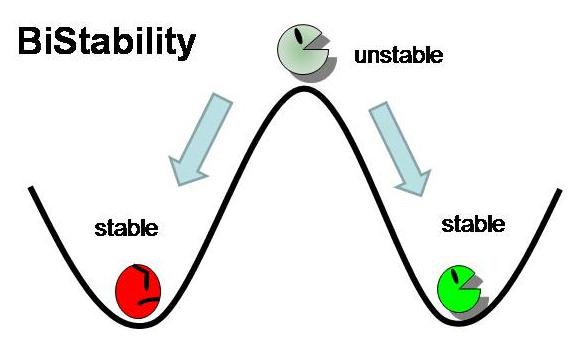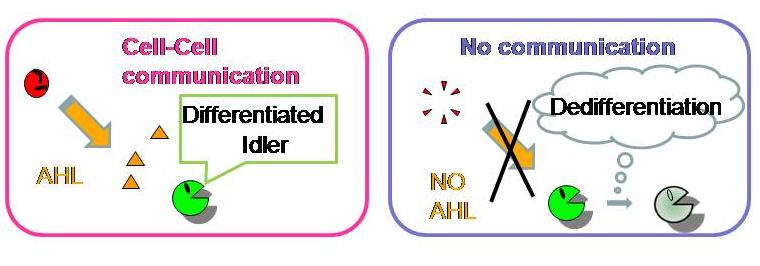Tokyo/Requirements
From 2007.igem.org
(→2. Cell-cell communication) |
(→2. Cell-cell communication) |
||
| (2 intermediate revisions not shown) | |||
| Line 9: | Line 9: | ||
== What is necessary for "Balanced differentiation"? == | == What is necessary for "Balanced differentiation"? == | ||
| - | The most important and underlying point of our model is that the system is stable against environmental changes when two types of differentiated individuals coexist, called "Balanced differentiation." Our project | + | The most important and underlying point of our model is that the system is stable against environmental changes when two types of differentiated individuals coexist, called "Balanced differentiation." Our project has aimed at this "Balanced differentiation" but not dynamic equilibrium such as chemical ones. |
<!--共存安定をなりたたせるために必要な要素は以下の3つである | <!--共存安定をなりたたせるために必要な要素は以下の3つである | ||
1.双安定 | 1.双安定 | ||
| Line 15: | Line 15: | ||
3.2つの機能が1つの細胞から実現されること--> | 3.2つの機能が1つの細胞から実現されること--> | ||
<br>To achieve this “Balanced differentiation", our model requires | <br>To achieve this “Balanced differentiation", our model requires | ||
| - | <br>1. differentiation(=bistability) generated by | + | <br>1. differentiation(=bistability) generated by mutual-inhibition circuit. |
| - | <br>2. cell-cell communication by | + | <br>2. cell-cell communication by quorum sensing |
| Line 40: | Line 40: | ||
====2. Cell-cell communication ==== | ====2. Cell-cell communication ==== | ||
| - | When this balanced differentiation is disrupted, by removing all the A | + | When this balanced differentiation is disrupted, by removing all the A types for example, the rest individual B cells sense the change. Their differentiated states become unstable as if they become upset. Then all cells dedifferentiate, but after a while, redifferentiation is triggered by cell-cell communication. As a result, at a certain ratio of A and B again, the whole system comes back to a stable state. |
[[Image:Cellcell.JPG|thumb|450px| '''Fig.2: Cell-cell communication'''<br>Intercellular interaction is established by communication molecule AHL. When enough AHL is produced by the workers, the idlers are stable; however, if it is not ~ communication being interrupted, ~ they dedifferentiate. Thus, cells can sense the surrounding cell types. ]] | [[Image:Cellcell.JPG|thumb|450px| '''Fig.2: Cell-cell communication'''<br>Intercellular interaction is established by communication molecule AHL. When enough AHL is produced by the workers, the idlers are stable; however, if it is not ~ communication being interrupted, ~ they dedifferentiate. Thus, cells can sense the surrounding cell types. ]] | ||
Latest revision as of 05:06, 27 October 2007
Abstract Concept & Model Requirements Genetic_circuit Works About_our_team
What is necessary for "Balanced differentiation"?
The most important and underlying point of our model is that the system is stable against environmental changes when two types of differentiated individuals coexist, called "Balanced differentiation." Our project has aimed at this "Balanced differentiation" but not dynamic equilibrium such as chemical ones.
To achieve this “Balanced differentiation", our model requires
1. differentiation(=bistability) generated by mutual-inhibition circuit.
2. cell-cell communication by quorum sensing
1. Differentiation(=bistability)
~ at an individual level ~
For "balanced differentiation" in our model, two types of cells should coexist stably. Therefore, cells with THE SAME GENE SET need to take either of TWO DIFFERENTIATED STATES, A (Worker) or B (Idler) in our project as shown in Fig. 1. In order to distinguish from dynamic stability, "balanced differentiation" must be achieved by two distinct states inconvertible each other. This bistability can be achieved by mutual-inhibition circuit.
2. Cell-cell communication
When this balanced differentiation is disrupted, by removing all the A types for example, the rest individual B cells sense the change. Their differentiated states become unstable as if they become upset. Then all cells dedifferentiate, but after a while, redifferentiation is triggered by cell-cell communication. As a result, at a certain ratio of A and B again, the whole system comes back to a stable state.

